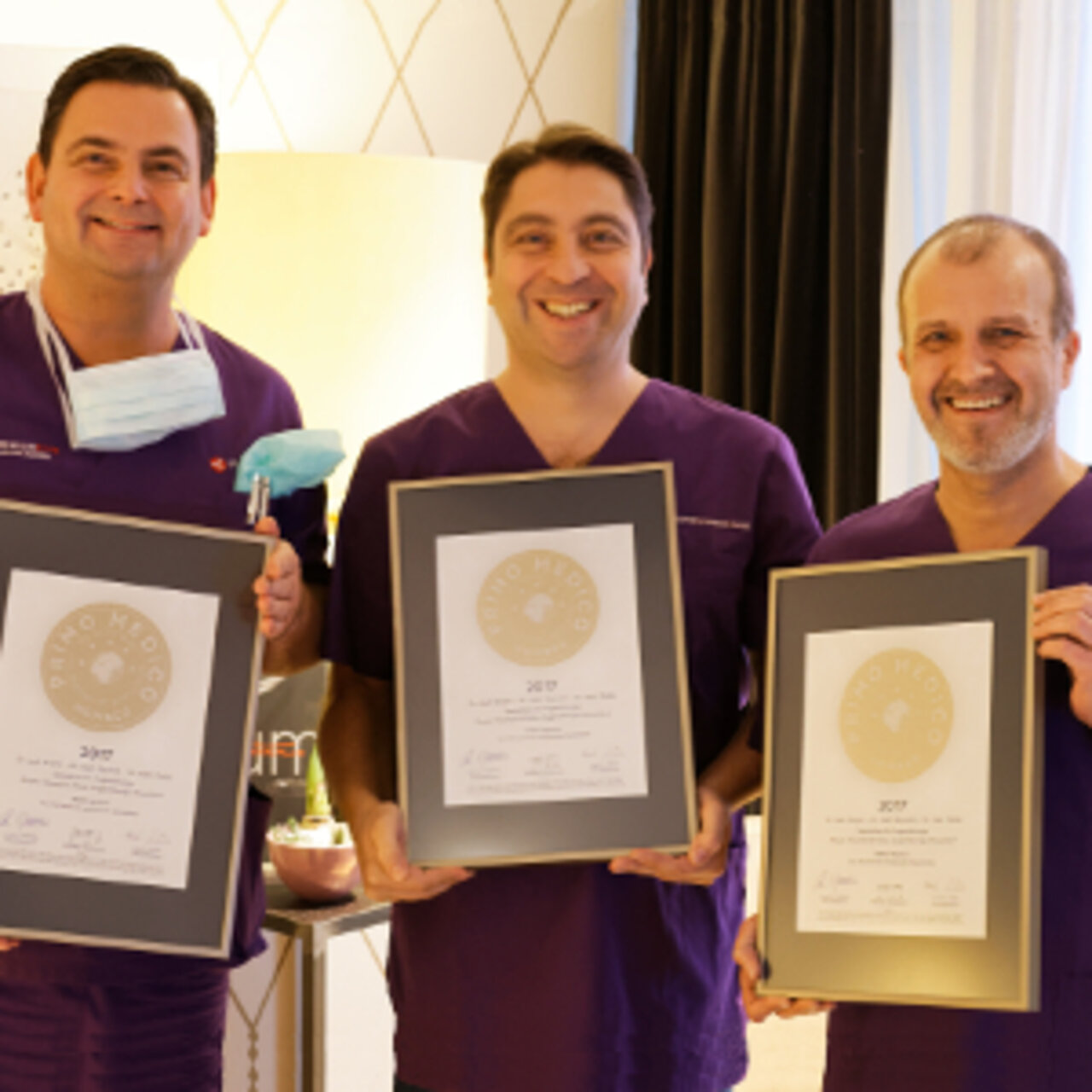Specialists in Myopia
3 Specialists found
Information About the Field of Myopia
What is myopia?
Short-sightedness (myopia) causes the patient to see distant objects blurry and out of focus, while seeing things close up in focus. By blinking or squinting the eyes, vision can be improved. Hence the name myopia: myein is Greek for blinking, or closing one's eyes.
Myopia represents the most common refractive error in Europe: more than 200 million people in Europe are short-sighted! The total numbers of nearsighted persons seem to be on the rise, and more and more young people are affected.
How can myopia develop?
The incoming rays of light are refracted by the lens and cornea and converge precisely on the retina. This creates a sharp image. If rays incident in parallel (= light rays from the distance) fail to meet on the retina, a blurry image is created. With myopia, the rays meet in the vitreous body which is in front of the retina. Usually, the eyeball of short-sighted people is too long in relation to the refractive power. Sometimes, the refractive power of the cornea and the lens is too strong.
In the case of keratoconus (protrusion of the cornea), spherical lens, cataract or forward displacement of the lens, for example. As the eye focuses on a near point, the rays do not enter in parallel, but they diverge. Normally, in order for the rays to strike the retina and form a sharp image, the eye requires an increase in the refractive power by accommodation (adjustment of the refractive power) of the lens. Because the eyeball of a short-sighted person is longer or the lens' refractive power is greater, it takes less or no accommodation of the lens to see close-up things in focus. Nevertheless, short-sighted people will see anything out of focus that is further away than the point which they can see sharply without lens accommodation.
Two forms of myopia can be distinguished. Simple myopia is mild to moderate myopia and usually starts at school age. It was once believed that reading, writing and other close activities at school are the cause of myopia, given the age at which myopia begins and progresses. The predisposition is inborn and frequently genetic, but it has been demonstrated in an animal experiment that altering the conditions of vision can in fact influence the growth of the eye in length.
High myopia (progressive or malignant myopia) is a rare disease which can be hereditary and is independent of extrinsic influences. In many cases, it is accompanied by severe changes in the eye.
Myopia can also arise in combination with other diseases, such as temporarily in diabetics, Marfan's syndrome as a result of a deficiency of the lens attachment or Down syndrome. Preterm babies are often short-sighted already as infants; glaucoma or changes of the cornea during childhood can lead to short-sightedness.
Myopia symptoms
Short-sighted people perceive close objects sharply and more distant objects blurry. Simple myopia frequently begins at the age of 10 to 12 and in most cases does not progress after 25 or at the latest after 30 years of age. Patients with very mild myopia may manage well in everyday life and only require visual aids in situations where precise distance vision is needed, such as when driving a car.
The severity of myopia is measured in diopters. Myopia of -1 diopter means that the person can see things sharply at a distance of up to one meter and everything beyond that point appears slightly blurred, while with myopia of -3 diopters, the person is only able to see things sharply at a distance of approximately 30 cm. Values of more than -6 diopters are rare in cases of simple myopia. If the myopia is very severe, only things at a distance of a few centimeters can be seen sharply and everything else is very blurry.
High myopia also causes changes in the back of the eye as the eyeball stretches. The choroid membrane is pulled apart. Both the retina and choroid will regress in the central area around the optic disc. Bleeding and scarring can develop. Scarring in the central retina greatly reduces vision. In severe cases, the retina may detach.
As life progresses, the vitreous body liquefies and becomes cloudy. This happens earlier in severely nearsighted people. Their vision becomes "fuzzy." In addition, severe nearsightedness promotes the development of glaucoma.
How to correct myopia
Glasses
Eyeglasses can correct short-sightedness. Glasses for myopia have a concave lens, which is also referred to as a minus lens or diverging lens. The glass is thicker at the edges than at the middle. The incoming light rays are further diverted by the concave lens, so their meeting point in the eye is moved backwards, preferably onto the retina. The ophthalmologist determines the short-sightedness by having the patient look through lenses of different strengths. Then, the weakest minus lens that allows for sharp vision is chosen. With a slightly too powerful lens, patients would be able to see just as well, since they can compensate for the overcorrection by accommodation. However, constant need for accommodation can cause headaches. That is why no lens stronger than necessary should be prescribed. In case of very strong myopia of more than -15 diopters, glasses reach their corrective limit. Due to deformations of the back of the eye and as the glasses greatly reduced the retinal image size, the vision is impaired. The lenses are heavy and have thick rims. which is why vision is worse in peripheral zones. Contact lenses are better suited to compensate for severe myopia.
Contact lenses
Contact lenses can correct myopia. Just like spectacle lenses, they function like a dispersing lens while they stick to the cornea. There are stable contact lenses, which retain their shape when taken out as well as soft contact lenses, which are deformable and need to be stored in liquid. Patients usually request contact lenses for cosmetic reasons. However, contact lenses also have other advantages: they don't narrow the field of vision and don't fog up. With more severe myopia, patients find contact lenses more comfortable than glasses because the lenses of glasses are thick. Like mentioned above, contacts can also correct very severe myopia of -15 diopters, unlike glasses. However, not everyone can bear having contact lenses in all day. Like a foreign body, they may irritate the eye. Clumsy replacement and incorrect cleaning can injure the cornea, bring in bacteria and lead to infections.
Laser or surgery for myopia - Can myopia be surgically corrected?
Yes, myopia can be corrected surgically and involves modifying the refractive power of the cornea or correcting the refractive error of the lens. The Commission for Refractive Surgery of the German Ophthalmological Society and the Professional Association of German Ophthalmologists recommend the following methods for ocular surface treatment, eye laser surgery and artificial lenses:
PRK (photorefractive keratectomy), trans- PRK or LASEK
Ocular surface treatments such as PRK (photorefractive keratectomy), trans- PRK or LASEK are recommended for myopia of up to -6 diopters, in some cases up to -8 diopters. The Refractive Surgery Commission defines this limit range: surgery can be performed, but outcomes become progressively worse and side effects more frequent which is why patients need to be thoroughly educated. Ocular surface treatments, involve ablateing the cornea in its center with the Eximer laser. To compensate for the refractive error, the cornea is flattened. Subsequently, a temporary contact lens is fitted, beneath which the superficial lesion can heal in a few days.
LASIK and femto-LASIK
LASIK (laser-assisted in-situ keratomileusis) and femto-LASIK can be applied for myopia up to -8 diopters, with some limitations up to -10 diopters. In LASIK, a layer of 0.1 to 0.15 mm in thickness is partially detached from the cornea with a microkeratome, a highly advanced microscalpel, and flipped over. Using the Eximer laser, surgeons ablate the inside of the cornea centrally. The result is a more shallow bulge. Finally, the the folded corneal layer is placed back on top. The corneal layer will grow on by itself. Femto-LASIK is a more recent form of LASIK. In this method, the microkeratome is replaced by a femtosecond laser.
Refractive lenticule extraction (ReLEx)
Refractive lenticule extraction (ReLEx) takes advantage of a femtosecond laser and is recommended for myopia up to -8 diopters, in some cases up to -10 diopters. This method uses only the femtosecond laser. In ReLEx FLEx, a tissue slice is obtained by a double incision using the femtosecond laser. The upper corneal flap is elevated, the tissue slice is removed and the initial flap is folded back. It will heal on its own. With ReLEx SMILE, the tissue flap is removed via two incisions on the side without the need to lift the flap.
Artificial lens implantation
In case of myopia starting from -3 diopters, artificial lens implantation (phakic intraocular lens or PIOL) is also possible. During this procedure, the surgeon opens the eye at the corneal edge and places an additional artificial lens into the eye. The artificial lens resembles a contact lens and can either be fixated to the iris in the anterior chamber or fitted in the angle of the chamber, but it may also be implanted behind the iris above the lens. The incision can be stitched back together but it can also heal without sutures. For mild myopia starting from -1 diopter, this method is indicated only in some patients. Another possibility is to exchange the innate lens with an artificial lens (RLE or refractive lens exchange). RLE is indicated if myopia is accompanied by presbyopia.
Surgery or laser treatment for myopia – from what age on?
Laser eye surgery (LASIK, femto-LASIK or ocular surface treatment), implantation of an intraocular lens or refractive lens exchange should only be carried out after the age of 17.
Laser treatment or surgery for myopia – what risks are associated?
During the first few hours following surface treatment of the eye, patients have worse vision and have moderate, rarely severe pain. During the first week, the corneal pit will partially be refilled with corneal epithelium. For this reason, temporary worsening of myopia is possible. Scarring of the cornea is possible, too. Patients frequently complain about increased dryness of the eyes and also vision during dawn can be restricted: patients may perceive halos around light sources and shadow images.
Following LASIK, femto-LASIK as well as ReLEx, patients initially have worse vision with moderate discomfort. Just like experienced after surface treatment, the outcome can worsen during the first weeks, eyes can become progressively drier and vision at dawn may deteriorate. Very rarely, mistakes may happen during corneal incision or ablation of the uppermost layer, folds of the corneal flap during healing (LASIK and femto-LASIK) as well as irregular cut surfaces may develop, the corneal slice may be incompletely removed, the cornea may be weakened or bulged outwards or inflammation, infection or excessive scarring may occur.
Generally, all methods have a greater risk of complications if the defect to be corrected is larger. For successful LASIK, femto-LASIK or ReLEx, the cornea itself as well as corneal tissue below the incision must be sufficient in thickness. LASIK, femto-LASIK or ReLEx should not be performed in cases of chronically progressive corneal disorders, cataract, glaucoma with severely impaired visual field, exudative macular degeneration or forme fruste keratoconus which is a type of corneal protrusion.
Phake intraocular lens (PIOL) implantation is rarely associated with the following complications: sudden increase of intraocular pressure, damage to the iris, changes in pupillary form, damage or clouding of the cornea, clouding of the lens, chronic inflammation and displacement of the artificial lens. In particular cases, the retina can detach which may lead to blindness. The artificial lens cannot be implanted should the patient suffer from glaucoma with a restricted visual field or if the inner corneal layer has suffered serious damage.
Which doctors and clinics specialize in myopia?
Eye examinations and prescription of glasses are routine tasks for most ophthalmologists. For eye examinations in children, pediatric ophthalmologists should be visited. In case of an indication to treat myopia surgically, there are doctors and clinics that specialize in refractive surgery. Today, modern techniques have reached a high quality level. Specialized ophthalmologists will first thoroughly examine the eyes and educate the patient before recommending the most suitable method based on the degree of myopia.
Let us help you find an expert for your condition. All doctors and clinics listed have been reviewed by us for their outstanding specialization in the field of myopia and are looking forward to your inquiry or wish for treatment.


